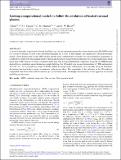Linking computational models to follow the evolution of heated coronal plasma
Abstract
A ‘proof of principle’ is presented, whereby the Ohmic and viscous heating determined by a three-dimensional (3D) MHD model of a coronal avalanche are used as the coronal heating input for a series of field-aligned, one-dimensional (1D) hydrodynamic models. Three-dimensional coronal MHD models require large computational resources. For current numerical parameters, it is difficult to model both the magnetic field evolution and the energy transport along field lines for coronal temperatures much hotter than 1MK, because of severe constraints on the time step from parallel thermal conduction. Using the 3D MHD heating derived from a simulation and evaluated on a single field line, the 1D models give coronal temperatures of 1MK and densities 1014--1015m−3 for a coronal loop length of 80Mm. While the temperatures and densities vary smoothly along the field lines, the heating function leads to strong asymmetries in the plasma flows. The magnitudes of the velocities in the 1D model are comparable with those seen in 3D reconnection jets in our earlier work. Advantages and drawbacks of this approach for coronal modelling are discussed.
Citation
Reid , J , Cargill , P , Johnston , C D & Hood , A W 2021 , ' Linking computational models to follow the evolution of heated coronal plasma ' , Monthly Notices of the Royal Astronomical Society , vol. 505 , no. 3 , pp. 4141-4150 . https://doi.org/10.1093/mnras/stab1255
Publication
Monthly Notices of the Royal Astronomical Society
Status
Peer reviewed
ISSN
1365-2966Type
Journal article
Description
Funding: JR acknowledges the support of the Carnegie Trust for the Universities of Scotland. JR and AWH acknowledge the financial support of STFC through the Consolidated grant, ST/S000402/1, to the University of St Andrews. AWH acknowledges support from ERC Synergy grant ‘The Whole Sun’ (810218). CDJ acknowledges funding from the European Research Council (ERC) under grant agreement No. 647214.Collections
Items in the St Andrews Research Repository are protected by copyright, with all rights reserved, unless otherwise indicated.

